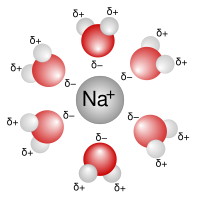
Photo from wikipedia
Water‐soluble chlorophyll‐binding proteins (WSCPs) from Brassicaceae constitute a small family of non‐photosynthetic proteins that may provide a useful benchmark and model system for studying molecular aspects of chlorophyll‐protein interactions such… Click to show full abstract
Water‐soluble chlorophyll‐binding proteins (WSCPs) from Brassicaceae constitute a small family of non‐photosynthetic proteins that may provide a useful benchmark and model system for studying molecular aspects of chlorophyll‐protein interactions such as the tuning of absorption and emission spectra, and binding selectivity. WSCP apo‐proteins are readily expressed by recombinant DNA techniques and can be assembled in vitro with natural and synthetic chlorophyll derivatives. The complexes with native chlorophylls are exceptionally stable toward thermal dissociation and protein denaturation due to hydrophobic interactions with the chlorophyll’s phytyl chains that stabilize the core of the WSCP tetrameric complexes. However, assembly requires the use of detergents or water‐in‐oil emulsions to introduce the hydrophobic pigments into the water‐soluble apo‐proteins. Here, we explore the direct assembly of recombinant WSCPs with the water‐soluble phytyl‐free chlorophyll analogue chlorophyllide a in aqueous solutions. We show that the complexes formed by mixing chlorophyllide and WSCP apo‐proteins are exclusively tetrameric, and while they lack the extreme thermostability of the respective chlorophyll complexes, they are still thermostable up to around 60°C. Their absorption and CD spectra are very similar to the chlorophyll complexes albeit slight peak shifts and broadening of the bands indicate variations in pigment and protein conformations, and less rigid structures. Simplifying the assembly process of WSCPs opens new possibilities for their use in modelling natural chlorophyll‐protein complexes, and as templates for designing novel artificial protein‐pigment complexes.
Journal Title: Photochemistry and Photobiology
Year Published: 2021
Link to full text (if available)
Share on Social Media: Sign Up to like & get
recommendations!